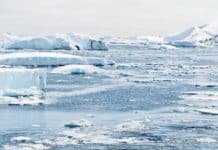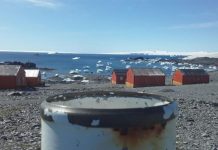PALO ALTO, Calif., Aug. 11 (UPI) — Rising temperatures and shrinking polar ice caps are worrisome longterm trends for most species, including fish and marine mammals. But sea life also benefits tremendously from nutrients-rich runoff streaming off melting glaciers.
Glacial meltwater carries concentrations of iron from the interior ice sheets to the gaps in the sea ice and the surrounding polar waters. The deposited iron results in what scientists call polynyas, where an abundance of iron-loving phytoplankton jumpstart feeding activity.
These feeding hotspots support penguins, seals, whales and more — and new research suggests they may be bolstered by melting trends in the Antarctic.
“These coastal polynyas are sensitive to inputs from adjacent glaciers, and these glaciers are probably going to accelerate their melting in the future, which is certainly going to have implications for these polynyas,” Kevin Arrigo, a biological oceanographer at Stanford, said in a press release. “Coastal Antarctica is likely to become a more productive place in the future.”
Arrigo is the author of a new study on the future of polar polynyas, published this weekin the Journal of Geophysical Research: Oceans.
Polynyas typically occur in the summer, as sea breaks up and is pulled away from the coast of Antarctica, creating a gap where meltwater can deposit the nutrients phytoplankton crave.
Improving satellite technology and increasing amounts of satellite data are making it easier for scientists to study the ecological dynamics of the Antarctic coast.
Satellite imagery reveals the growth of polynyas as expanding blobs of green amidst the deep blue of cold polar water. Recent analyses of satellite imagery, by Arrigo and his research partners, revealed the correlation between runoff volume and polynyas size.
The discovery has highlighted other potential unforeseen implications of polynyas — like their role in carbon sequestration. Explosions of phytoplankton may suck significant amounts of carbon from the atmosphere by way of photosynthesis.
“These polynyas appear to be disproportionately important, for their size, as sinks of carbon,” Arrigo said. “And the reality is that they really are not included in anyone’s carbon budget.”
Currently, Arrigo’s research is reliant on satellite data. He hopes that, moving forward, field measurements will aid his understanding of iron-rich polynyas, their role in the ecological web and how that role may change as a result of climate change.






